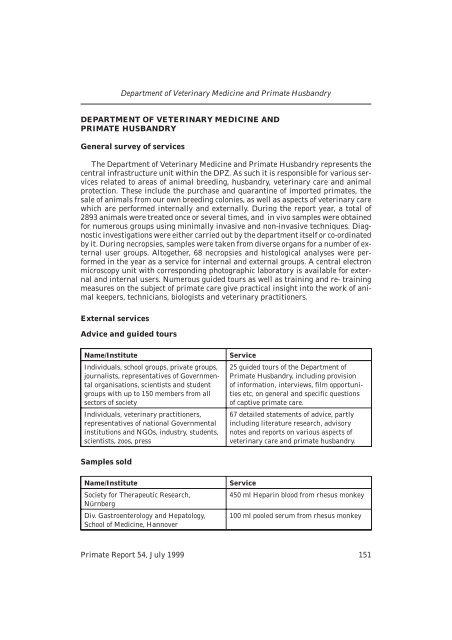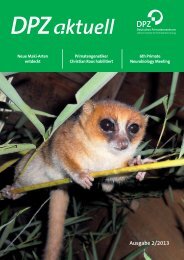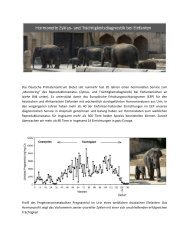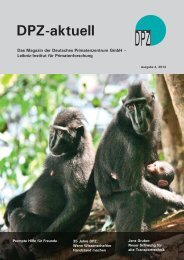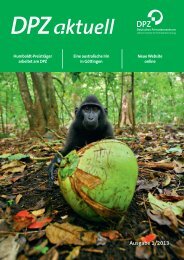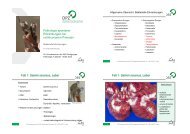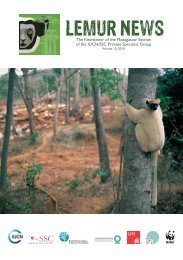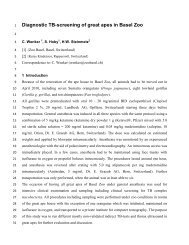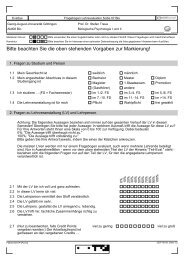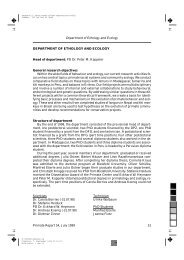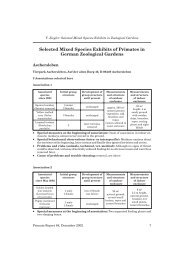DEPARTMENT OF VETERINARY MEDICINE AND PRIMATE ... - DPZ
DEPARTMENT OF VETERINARY MEDICINE AND PRIMATE ... - DPZ
DEPARTMENT OF VETERINARY MEDICINE AND PRIMATE ... - DPZ
You also want an ePaper? Increase the reach of your titles
YUMPU automatically turns print PDFs into web optimized ePapers that Google loves.
<strong>DEPARTMENT</strong> <strong>OF</strong> <strong>VETERINARY</strong> <strong>MEDICINE</strong> <strong>AND</strong><br />
<strong>PRIMATE</strong> HUSB<strong>AND</strong>RY<br />
General survey of services<br />
The Department of Veterinary Medicine and Primate Husbandry represents the<br />
central infrastructure unit within the <strong>DPZ</strong>. As such it is responsible for various services<br />
related to areas of animal breeding, husbandry, veterinary care and animal<br />
protection. These include the purchase and quarantine of imported primates, the<br />
sale of animals from our own breeding colonies, as well as aspects of veterinary care<br />
which are performed internally and externally. During the report year, a total of<br />
2893 animals were treated once or several times, and in vivo samples were obtained<br />
for numerous groups using minimally invasive and non-invasive techniques. Diagnostic<br />
investigations were either carried out by the department itself or co-ordinated<br />
by it. During necropsies, samples were taken from diverse organs for a number of external<br />
user groups. Altogether, 68 necropsies and histological analyses were performed<br />
in the year as a service for internal and external groups. A central electron<br />
microscopy unit with corresponding photographic laboratory is available for external<br />
and internal users. Numerous guided tours as well as training and re- training<br />
measures on the subject of primate care give practical insight into the work of animal<br />
keepers, technicians, biologists and veterinary practitioners.<br />
External services<br />
Advice and guided tours<br />
Name/Institute Service<br />
Individuals, school groups, private groups,<br />
journalists, representatives of Governmental<br />
organisations, scientists and student<br />
groups with up to 150 members from all<br />
sectors of society<br />
Individuals, veterinary practitioners,<br />
representatives of national Governmental<br />
institutions and NGOs, industry, students,<br />
scientists, zoos, press<br />
Samples sold<br />
Department of Veterinary Medicine and Primate Husbandry<br />
25 guided tours of the Department of<br />
Primate Husbandry, including provision<br />
of information, interviews, film opportunities<br />
etc, on general and specific questions<br />
of captive primate care.<br />
67 detailed statements of advice, partly<br />
including literature research, advisory<br />
notes and reports on various aspects of<br />
veterinary care and primate husbandry.<br />
Name/Institute Service<br />
Society for Therapeutic Research,<br />
Nürnberg<br />
450 ml Heparin blood from rhesus monkey<br />
Div. Gastroenterology and Hepatology,<br />
School of Medicine, Hannover<br />
100 ml pooled serum from rhesus monkey<br />
Primate Report 54, July 1999 151
Name/Institute Service<br />
Fa. Biomed. Heidelberg EDTA-blood samples from rhesus monkey<br />
Dept. Nuclear Medicine, University Hospital<br />
Benjamin Franklin, Free Univ. Berlin<br />
200 ml pooled monkey serum<br />
Fa. Hodawand, Bio-Immun-Labordiagnostik<br />
Ltd<br />
Oesophagus, marmoset spp. and rhesus<br />
monkey<br />
Fa. Euroimmun, Lübeck Organ samples from 5 cynomolgus monkeys<br />
Fa. MA BioServices, Heidelberg EDTA-blood samples from rhesus monkey<br />
Samples donated<br />
Department of Veterinary Medicine and Primate Husbandry<br />
Name/Institute Service<br />
Paul-Ehrlich-Institute, Langen<br />
Dr. Beer<br />
2 x 15 ml baboon heparinized blood<br />
Anthropology Dept. Columbia University,<br />
New York, USA<br />
Dr.A.J.Tosi<br />
Dept. Immunogenetics, University of<br />
Göttingen<br />
Prof. Dr. Günther<br />
Eye Clinic, University Hospital Tübingen<br />
PD Dr. J. Kremers<br />
Institute of Zoology, University of<br />
Heidelberg<br />
Bernhard-Nocht-Institute, Hamburg<br />
T. Greve<br />
Bernhard-Nocht-Institute, Hamburg<br />
Prof. Dr. Racz,<br />
Robert-Koch-Institute Berlin<br />
S. Biel<br />
Dept of Anatomy, University of Göttingen<br />
Prof. Dr. Meyer<br />
University of Göttingen<br />
Dr. T. Schulz<br />
5 ml blood from Macaca silenus<br />
Liver, lymph node and skin tissue from a<br />
healthy rhesus monkey and one suffering<br />
from enteritis; intestinal tissue from<br />
2 rhesus monkeys<br />
4 ml blood each from 20 male rhesus<br />
monkeys<br />
Blood samples from rhesus monkeys,<br />
cynomolgus monkeys, lion-tailed monkey<br />
Blood samples from different primate<br />
species (2 squirrel monkeys, 2 common<br />
marmosets, 3 lion-tailed macaques)<br />
Regular sampling of various lymphatic<br />
organs of SIV-infected rhesus monkeys<br />
Urine and blood samples from 3 immunodeficient<br />
rhesus monkeys and 2 cynomolgus<br />
monkeys, kidney tissue from 2 rhesus<br />
monkeys<br />
Eyes of 5 elderly rhesus monkeys originating<br />
from Cayo Santiago, Puerto Rico<br />
Liver, kidney, lung, pancreas of 8 rhesus<br />
monkeys, frozen and fixed in formalin<br />
152 Primate Report 54, July 1999
Department of Veterinary Medicine and Primate Husbandry<br />
Name/Institute Service<br />
University of Leipzig<br />
Prof. Dr. Überla<br />
Lower Saxonian Institute for Peptide<br />
Research, Hannover<br />
Dr. Mägert<br />
University of Würzburg<br />
Dr. Sopper<br />
11 necropsies incl. histological analysis of<br />
immunodeficient rhesus monkeys<br />
Frozen liver tissue from 8 rhesus monkeys<br />
3 necropsies including CNS-Perfusions and<br />
histological analysis in rhesus monkeys<br />
Animal Park Gettorf Necropsy and histological analysis of a<br />
black-tufted ear marmoset (Callithrix<br />
penicillata)<br />
Dept Nephrology, School of Medicine, Skin from 6 marmosets<br />
Hannover<br />
Prof. Dr. Floege,<br />
Veterinary practitioner Kopp Pancreas of 2 rhesus monkeys<br />
Leibniz Research Laboratories for Biotechnology<br />
and Artificial Organs, Hannover<br />
Dr. Martin<br />
Institute for Molecular Virology, University<br />
of Nürnberg-Erlangen<br />
PD Dr. Fickenscher<br />
School of Medicine, Hannover<br />
Dr. Ahrends<br />
Institute of Pathology, School of Veterinary<br />
Medicine, Hannover<br />
Dr. U. Hetzel<br />
Veterinary services performed at cost<br />
Blood samples and vascular endothelias<br />
from squirrel monkeys, common marmosets,<br />
rhesus monkeys, cynomolgus monkeys<br />
Blood samples from squirrel monkeys<br />
Arteries and veins in cell culture medium<br />
from 4 cynomolgus monkeys<br />
Eyes from various primate species<br />
Name/Institute Service<br />
Animal Park Gronau Microbiological, virological and parasitological<br />
analysis of blood and faecal samples<br />
from 12 baboons (in collaboration with<br />
Dept. Pathology)<br />
Animal Park Nordhorn<br />
Dr. Kramer<br />
Microbiological and parasitological analyses<br />
(in collaboration with Dept. Pathology)<br />
Animal Park Daun Clinical analyses including tuberculinization,<br />
sampling for microbiological, parasitological<br />
and haematological analysis of<br />
barbary macaques<br />
Primate Report 54, July 1999 153
Veterinary services donated<br />
Name/Institute Service<br />
Ecopark Frankenau Explantation of a contraceptive in a cottontop<br />
tamarin<br />
Max von Pettenkofer-Institute, München<br />
Prof. Dr. G. Frösner<br />
Histological analysis of ISH-marked brain<br />
and liver sections of a brown-headed<br />
tamarin<br />
Animal Park Dortmund Necropsy and histological analysis of a<br />
squirrel monkey<br />
Endocrinology, Dept. Obstetrics and<br />
Gynecology, University of Göttingen<br />
Dr. I. Knoke<br />
Landesanstalt für veterinärmedizinische<br />
Untersuchungen Ehrental, A<br />
Bayer AG Wuppertal<br />
PD Dr. Rosenbruch<br />
Histological analysis of a porcine Corpora<br />
lutea<br />
Postmortal determination of age in a<br />
squirrel monkey<br />
Histological analysis of liver sections of a<br />
cynomolgus monkey<br />
Ebbs Zoo, A Clinical-ethological and dermato-pathological<br />
analysis of alopecia in a rhesus<br />
monkey colony<br />
Hannover Zoo<br />
Dr. Knüfermann<br />
Institute of Anthropology, University of<br />
Göttingen<br />
Prof. Dr. Rothe<br />
Cell Biology, Laboratory of the Dept.<br />
Obstetrics and Gynecology, University<br />
of Göttingen<br />
PD Dr. Augustin<br />
Robert-Koch-Institute Berlin<br />
Dr. Gelderblom<br />
Immunohistological analysis of SIVexpression<br />
in 3 orang-utan lymphomas<br />
Veterinary care of the Callithrix-colony<br />
Provision of electron microscopy preparations<br />
including semi- and ultrathin<br />
sections for various investigations<br />
Participation in the 6 th open experiment in<br />
electron microscopical viral diagnosis<br />
Zoo Stendal Necropsy and histological analysis of a<br />
senile lion-tailed macaque<br />
Biomedical Primate Research Centre,<br />
Rijswijk, NL<br />
Dr. E.-M. Kuhn,<br />
Nienburg<br />
Dr. Barkhoff<br />
Department of Veterinary Medicine and Primate Husbandry<br />
Wild Animal Park, Springe<br />
Dr. J. Müller<br />
Light- and electron microscopical analysis<br />
of selected cases in primate pathology<br />
Histological analysis of different feline eye<br />
diseases with corresponding histological<br />
documentations<br />
Histological analysis of tissue from different<br />
wild animal species.<br />
154 Primate Report 54, July 1999
Teaching and education<br />
University teaching<br />
F-J. Kaup<br />
• 2-hour seminar, postgraduate studies in pathology, summer term 1998: 15.04.98,<br />
Pathology of the Immunodeficiency Syndrome, School of Veterinary Medicine,<br />
Hannover.<br />
• Lecture series on the special pathology of the liver, 25., 26. and 02.05.98, School of<br />
Veterinary Medicine, Hannover.<br />
• Lecture “Pathology of the Immunodeficiency Syndrome in animals”, 24.05.98.<br />
• “Primates in experimental research: Primate biology and husbandry”. 2-hour<br />
postgraduate seminar „Use of animals in experimental research“, 16.04.98.<br />
• Participation in the postgraduate school ‚Perspectives of primatology: Integration<br />
of genetic, neurobiological and ethological areas of primate research‘.<br />
• Examiner at the School of Veterinary Medicine for the subjects General Pathology,<br />
Pathological Anatomy and Histology: Preliminary examination of 32 students in<br />
their 6th and 10th term (19.03., 20.03., 26.03., 18.09.98).<br />
• PhD examinations at the School of Veterinary Medicine: F. Brandes, S. Müller, S.<br />
Dag, T. Kopp, T. Kurth.<br />
W. Kaumanns<br />
Department of Veterinary Medicine and Primate Husbandry<br />
• “Social behaviour of Primates.“ 1-week joint seminar with Köln University (Prof.<br />
Dr. Dambach) and Köln Zoo, 22.-26.06.98 (summer term 1998)<br />
Candidates for Diploma (D) and Doctorate (P)<br />
University/Name Dissertation<br />
School of Veterinary Medicine, Hannover<br />
A. Didier (P)<br />
School of Veterinary Medicine, Hannover<br />
S. Freire Bruno (P)<br />
School of Veterinary Medicine, Hannover<br />
T. A. M. Janetzko (P)<br />
Establishment of quantitative, competitive<br />
PCR and RT-PCR to determine virus load<br />
in intestinal biopsies of SIV-infected rhesus<br />
monkeys<br />
Immunohistochemical analysis of lymphocyte<br />
subpopulations in the cecum, ileum<br />
and the ileocecal lymph nodes in SIVinfected<br />
rhesus monkeys (Macaca<br />
mulatta)<br />
Immunohistochemical analysis of intestinal<br />
biopsies: The distribution of immunocompetent<br />
cells in the GALT-system in rhesus<br />
monkeys experimentally infected with SIV<br />
Primate Report 54, July 1999 155
University/Name Dissertation<br />
School of Veterinary Medicine, Hannover<br />
C. Kahnt (P)<br />
School of Veterinary Medicine, Hannover<br />
B. Steuerwald (P)<br />
School of Veterinary Medicine, Hannover<br />
E. Kunz (P)<br />
School of Veterinary Medicine, Hannover<br />
U. Brandenburg (P)<br />
School of Veterinary Medicine, Hannover<br />
H. Steinmetz (P)<br />
School of Veterinary Medicine, Hannover<br />
T. Koch (P)<br />
School of Veterinary Medicine, Hannover<br />
D. Deppe (P)<br />
School of Veterinary Medicine, Hannover<br />
N. Kempermann (P)<br />
University of Gießen<br />
K. Hampe (P)<br />
University of Tübingen<br />
D. Stahl (P)<br />
University of Köln<br />
E. Krebs (P)<br />
Universidad Complutense de Madrid<br />
M. Esteban (P)<br />
University of Köln<br />
C. Schwitzer (D)<br />
Department of Veterinary Medicine and Primate Husbandry<br />
University of Göttingen<br />
A. Arms (D)<br />
University of Göttingen<br />
P. Schmid (D)<br />
Immunohistochemical analysis of SIVassociated<br />
lymphomas in rhesus monkeys<br />
Morphological analysis of the epithelium in<br />
SIV-infected monkeys with special reference<br />
to Helicobacter-infections<br />
Experimental Helicobacter pylori infection<br />
in rhesus monkeys<br />
On the epidemiology of Helicobacteriosis<br />
in humans: An investigation of Helicobacter-infected<br />
cats<br />
Alopecia in captive rhesus monkeys<br />
Morphological analysis of rat mutants<br />
lacking endothelium receptors, a model<br />
for Hirschsprung-disease<br />
The concentration of carcinoembryonic antigen<br />
(CEA) and alphafetoprotein (AFP)<br />
during the course of disease in the serum<br />
of dogs with mammary tumors<br />
The concentration of carcinoembryonic<br />
antigen (CEA) and alphafetoprotein (AFP)<br />
in the serum of dogs with skin tumors<br />
Nutrition in captive primates<br />
Social structures and feeding behaviour in<br />
sooty mangabeys<br />
Birth control and social behaviour in<br />
hamadryas baboons<br />
The effect of post-partum estrus and the<br />
birth of an infant on the mother-child<br />
relationship in rhesus monkeys<br />
Feeding behaviour in red ruffed lemurs<br />
Examination and biomechanical analysis<br />
of locomotion in cotton-top tamarins and<br />
squirrel monkeys<br />
Long-term effects of demographic and<br />
social structures on the development of<br />
the European population of lion-tailed<br />
macaques<br />
156 Primate Report 54, July 1999
University/Name Dissertation<br />
University of Nürnberg-Erlangen<br />
K. Drueppel (D)<br />
Tool use in mandrills<br />
Further education<br />
Department of Veterinary Medicine and Primate Husbandry<br />
• F.-J. Kaup is licensed by the Lower Saxonian Chamber of Veterinarians to carry<br />
out further training leading to a specialist veterinary qualification in Pathology.<br />
He is also a member of the examination boards for the specialist veterinary qualifications<br />
in pathology, wild animal care and zoo animals. In 1998, two colleagues<br />
working at the <strong>DPZ</strong> (Dr. E-M. Kuhn, BPRC Rijkswijk) or tutored by <strong>DPZ</strong> staff (Dr.<br />
G. Lösenbeck, Fa. Laboklin, Bad Kissingen) passed the specialist veterinary examinations<br />
for pathology. In addition to another examination for the specialist<br />
veterinary qualification in pathology, an examination was carried out for the specialist<br />
qualification in wild animal care and two examinations for the specialist<br />
veterinary qualification in meat hygiene.<br />
• K. Wolkenhauer, a student of veterinary medicine, spent a period of practical<br />
training in the Department of Pathology and Veterinary Medicine from 11.05.-<br />
19.06.98. During this period she carried out an immunohistological analysis of<br />
apoptosis in the lymph nodes of rhesus monkeys.<br />
• Dr. J. Hauser, Working Group ‚Brain research‘ at the University of Freiburg, completed<br />
a three-day <strong>DPZ</strong> training course on aspects of veterinary care and husbandry<br />
of primates used in experimental research, from 01.-03.12.98.<br />
• A one-day training seminar for high school teachers was carried out at Nürnberg<br />
Zoo on 29.04.98. The seminar included practical exercises on the social behaviour<br />
of primates.<br />
• D. Wolters, training at the Institute of Veterinary Medicine, Göttingen University<br />
for a qualification as a biological laboratory technician, worked with the project<br />
group between 15.06.-15.08.98 as part of her professional training.<br />
• A regular series of lectures was held on diseases of pets, histological techniques<br />
and immunohistology. Examinations were carried out in conjunction with the local<br />
government of Hannover at the College for Veterinary Technicians, School of<br />
Veterinary Medicine, Hannover, during the winter term 97/98, summer term 98<br />
and winter term 98/99.<br />
• On behalf of the statutory veterinary office, R. Wagner, responsible for animal care<br />
at Daun zoo, was examined on the subject of primate husbandry.<br />
• A. Husung, Department of Primate Husbandry, is a Committee Member of the<br />
Special Interest Group of Animal Care Staff within the Society of Experimental<br />
Animal Care (IgTP-GV Solas).<br />
Primate Report 54, July 1999 157
Department of Veterinary Medicine and Primate Husbandry<br />
• The following includes people from various Institutes who have completed practicals,<br />
training and re-training measures in the field of animal care of nonhuman<br />
primates:<br />
B. Oppermann (10.11.97-12.06.98), N. Rudolph (10.11.97-31.01.98), D. Rothbart<br />
(01.08.97-31.07.99), E. Herdt (19.-30.10.98), E. Joussen (08.- 27.03.98), B. Wörner<br />
(15.06.98), H. Lehmeier (23.11.- 05.12.98), and T. Nolte (02.-13.11.98).<br />
158 Primate Report 54, July 1999


